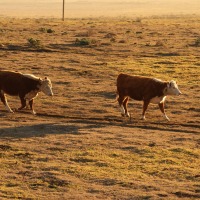

DIY Fodder System – Growing Winter Fodder for Livestock

Winter grazing strategies
Livestock feed can be expensive; however, you can grow your own fodder with a DIY fodder system. Think about it, when winter comes, most of your summer and fall grasses such as Bermudagrass and Bahiagrass will become dormant and unproductive.
During the winter, most of your pasture may be covered with snow. Feeding your animals with hay is not a productive solution either. Planting species such as ryegrass, wheat and oats are some of the winter pasture crops that you could grow for winter grazing. It may seem feasible but you will still need some feed to supplement your pastures.
If you have applied rotational grazing techniques all though the summer and fall, you should not stop your intensive grazing rotation process because of the winter. Success of your winter rotational grazing will depend on how well you prepare your pastures during the growing seasons. You could try growing small grains such as wheat, oats or rye and ryegrass. These are some of the effective solution for winter grazing.
(Also read: Leading Cattle in Pasture & Rotational Grazing.)
Efficient grazing techniques
Managing pastures and grazing efficiently is critical for cutting costs. During the feed shortage periods, you need to utilize most of your forage resources and make the best use of your pasture. Proper grazing techniques will surely reduce your feeding costs.
DIY Homemade Fodder System
 A fodder system is easy to make. It uses seeds from wheat, ryegrass, barley and oats to produce enough microgreen grasses for ruminants to keep them healthy throughout the cold seasons. Microgreen fodder grasses are healthy, nutritious and highly digestible for ruminants. Your animals will simply love the taste of them.
A fodder system is easy to make. It uses seeds from wheat, ryegrass, barley and oats to produce enough microgreen grasses for ruminants to keep them healthy throughout the cold seasons. Microgreen fodder grasses are healthy, nutritious and highly digestible for ruminants. Your animals will simply love the taste of them.
What you’ll need
To start building a fodder system, first determine how much fodder you want to produce. For a small farm, indoor fodder systems work just fine. You will need to make sure that you have enough sunlight water and air ventilation for your grasses to grow throughout the cold season.
The fodder system that we are describing uses a hydroponic, soilless system, that takes very little time and resources to work.
The construction of your fodder system can be very simple, using plastic or metal trays or tubs. You will need seeds, trays with holes, water, and a rack to mount your trays.
The Process
You can grow your own grasses from sprouting seeds with the microgreen fodder system described below. Grasses grown in this microgreen fodder system is an excellent way to supplement your livestock during winter and feed shortages. It’s also a cost effective way to produce your own fodder.
- Take a plastic tub or tray and rinse it out with water and bleach for getting rid of molds and germs.
- Take another tray or tub with holes in the bottom. Measure and pour 30 ounces of barley seeds into the tub. Rinse off the seeds with bleach. You can use several trays for sprouting.
- Rinse the new barley seed well, and pour off the chaff. Place your tray on top of the tray with no holes and fill with water enough to cover the seeds.
- Your fodder will start to grow. Water your trays every day and drain excessive water away, making sure that fodder don’t spill out.
- Soak your trays for about 12 hours.
- Water the top tray and all other trays will receive water. Keep the growing mat to fodder wet, but not overly wet.
- You will see microgreen grasses growing after 1-2 days.
- You should harvest after 4-6 days. DO NOT LET YOUR FODDER MAT GROW BEYOND 6 DAYS. This is controversial and we will talk about why not to allow longer growth in another article.
Now you don’t have to spend a huge amount of time and money to build your own production system. However, if you think you don’t have enough time to grown your own fodder, you can buy 15 to 20 lb. flakes from local producers on a daily basis to feed your animals. How cool is that?
Why Feed Hydroponic Microgreens/Fodder
Video Source: Sustainable Livestock Nutrition
Hope you found our article useful. You could grow luscious, highly digestible micro-green grasses Click here to get DIY plans for proven livestock feeding systems.
Please contact us at 303-495-3705 or Click here to book a meeting with us if you have any questions or comments. Also, feel free to leave your questions or comments in the comment box below or visit our Facebook Page. We’d really appreciate it, and it would also be really cool if you like our page.
Source: Sustainable Livestock Nutrition
Related articles and resources:
- Grazing Techniques that Reduce Feeding Costs | Sustainable Livestock Nutrition
- Livestock Care & Forage Management for Fall & Winter | Sustainable Livestock Nutrition
- Dead Simple Fodder System | Brink of Freedom
- Creating Livestock Feed from Sprouted Fodder System | Sustainable Livestock Nutrition
- Grazing Techniques that Reduce Feeding Costs | Sustainable Livestock Nutrition
 One Response
One Response 






I understand we’re talking Pizza Macedon NY,
yet their wings are ouut off the pizza as well as tis
globe is consistently wonderful.